Tell me if this sounds familiar.
You’ve heard the term “juxtaposition” but you’re not quite sure how it’s used.
Heck, you’re not even sure how to define juxtaposition.
Well, you’re not alone.
But I want to let you in on a little secret:
This literary device can transform your writing from dead and dull to captivating and thought-provoking.
How so, you ask?
Well, first we have to get clear on the juxtaposition definition. Then we’ll cover some juxtaposition examples to show you how this works.
Ready?
Let’s dive in.
What is Juxtaposition?
Simply put, juxtaposition is a literary device that places two things side by side for a contrasting effect.
For example, consider how the Yin and Yang symbol has contrasting colors. This creates a visual juxtaposition between the black and white.
But here’s the deal:
Juxtaposition is an umbrella literary technique that includes more specific types of contrasts. Oxymorons, foils, and antitheses all fall under this juxtaposition umbrella.
Let’s briefly define each:
- Oxymoron is when words have conflicting meanings. Examples include phrases like “bittersweet” and “icy hot.”
- Foil is where characters contrast. For example, Dr. Jekyll and Mr. Hyde are foil characters because Jekyll is a respectable doctor while Mr. Hyde is a violent man.
- Antithesis places two opposite ideas together. Neil Armstrong said, “One small step for man, but one giant leap for mankind.” The phrases, “one small step” and “one giant leap” are contrasting ideas.
So far, so good?
Now let’s look at some examples and get a better idea.
20 Juxtaposition Examples
There’s no doubt about it.
Part of what makes juxtaposition so powerful is its versatility. Characters, images, objects, and ideas can all be juxtaposed with one another.
More importantly?
It’s used everywhere. Here are a few places you’ll find it:
- Movies
- Music
- Art
- Pop culture
- News
- Blog posts
- Essays
- Copywriting
- Literature
Speaking of literature, that’s a good place to start.
Examples of Juxtaposition from Literature

One of the most classic juxtaposition examples comes from Robert Frost’s poetry:
“Two roads diverged in a wood, and I-
I took the one less traveled by,
And that has made all the difference.”
Remember that poem?
Frost’s juxtaposition highlights the contrast between the two paths. One path is well-worn while the other is less traveled.
A Tale of Two Cities by Charles Dickens is another classic example. In this story, Dickens writes:
“It was the best of times, it was the worst of times.”
After reading that, you might wonder:
The best of times and worst? Is that possible?
Then you realize Dickens is using these contrasting elements to demonstrate the highs and lows of life.
Do you see what Dickens just did?
He made you stop and think. And that’s one of the main goals of juxtaposition.
We also see a similar example in Francis Edward Smedley’s novel Frank Fairleigh. He has a sentence that says:
“All is fair in love and war.”
Smedley places the two contrasting concepts, love and war, together to form an oxymoron.
Then we have a good ol’ fashioned good versus evil juxtaposition.
And who better to do it than Shakespeare?
In Shakespeare’s Othello, Iago is the evil “friend” who manipulates the good guy, Othello.
Othello loves his wife, but he allows his evil side to murder her out of jealously. Shakespeare used this foil technique to make an interesting storyline.
So interesting, in fact, that he used several juxtapositions throughout his work.
Here’s another example:
In A Midsummer Night’s Dream, Shakespeare writes:
“That is hot ice, and wondrous strange snow!”
Hot and ice contrast each other to create the perfect oxymoron.
Still with me?
Now let’s turn to the big screen.
Juxtaposition Examples in Movies and TV
You remember watching The Lion King for the first time, right?
It’s the most popular Disney film of all time — earning the company over $8 billion since it was released.
The storyline?
Good versus evil.
We see two brothers, Mufasa and Scar, battle it out until one of them dies. In case you haven’t seen it, I won’t spoil the ending but…
Here’s a scene showing their two clashing personalities:
We see more good versus evil juxtapositions from the Harry Potter series.
Harry plays the hero while Voldermort plays the “most evil wizard for hundreds and hundreds of years.”
Now you might be asking:
Why is the good versus evil theme so common?
Simple. Because it grabs your attention and gives you a side to root for.
And just like that?
You’re invested in the storyline because of it.
Now let’s shift gears to a funny foil example. Take a look at the trailer for Pixar’s movie Up:
Carl Fredricksen is a cranky old man while Russell is a young energetic kid. Juxtaposing these two characters creates a hilarious dynamic between them.
Because here’s the thing:
If you can make your audience laugh, you win.
The writers behind The Simpsons knew humor better than anyone. Check out this funny clip where Homer adopts a pet lobster:
The juxtaposition here is that Homer sees the lobster, Mr. Pinchy, as a loving pet while Marge sees it as the object of all evil. This creates a hilarious scene based on opposing viewpoints.
Speaking of opposites, do you believe they attract?
They definitely did in the film Pretty Woman.
The main character, Vivian, is a young escort working the streets of LA. Her love interest, Edward, is a successful older man with years of business experience under his belt.
This foil formed a striking juxtaposition and gave credence to the saying “opposites attract.”
Juxtaposition in Art
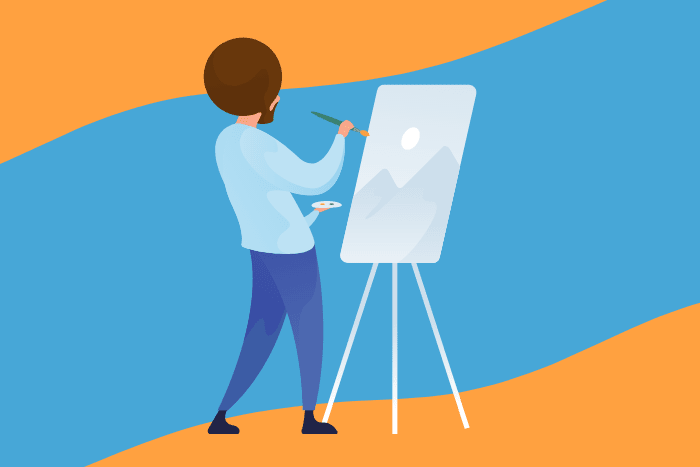
Here’s something you might not know:
Visual juxtaposition is a basic principle that artists use all over the world.
For example, we see juxtaposition photography and paintings all the time.
Case in point:
Renaissance painters used the contrast between light and darkness to differentiate between main figures and their backgrounds.
The reason?
It gave their paintings depth and drew attention to a main focal point.
Now the question is…
Can visual juxtaposition include more than just black and white?
Yup. Here are a few common juxtaposition examples in art:
- Texture contrast (smooth versus rough)
- Shape contrast (square versus circle)
- Edge contrast (rough edge versus soft edge)
- Hue contrast (orange versus blue)
Hue contrasts were one of Vincent Van Gogh’s favorite techniques. In Olive Grove, he used a sharp hue contrast to create a stunning effect using complementary colors.
But that’s not all.
Vincent Van Gogh also played around with sensory details by incorporating textures in his work.
What do I mean by textures?
Here are a few examples:
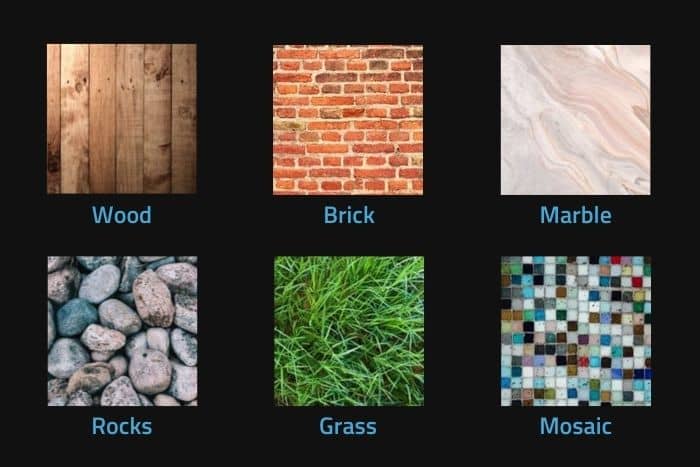
Putting together different subjects, textures, and shapes creates a visual juxtaposition.
For example, the shape composition technique uses big versus small, circles versus squares, and so on.
We see that here:
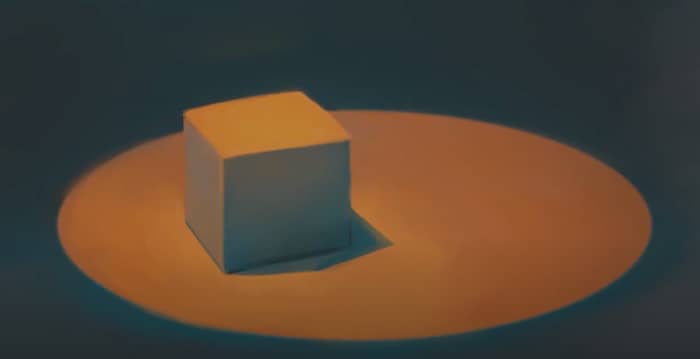
Source: Ctrl+Paint
Notice how the artist places the square box inside the circular spotlight?
You can also find juxtaposition in architecture, street photography, and even graffiti.
For example, you might see a colorful montage of graffiti paired with a contrasting background.
Photographers love how beautifully the colors contrast, so they’ll take juxtaposition photos of it.
Pretty neat, huh?
Juxtaposition in Songs
Remember listening to LL Cool J as a kid?
No? Just me?
Alright, well, his song “Hollis to Hollywood” has these lyrics:
I’m makin’ Speed like I’m Keanu Reeves
But too many True Lies can make a honey please
Placing “true” and “lies” together makes an oxymoron.
Another oxymoron example comes from the Kinks song “Definite Maybe”:
All I want is a yes or a no,
But all I ever get is a definite maybe.
It’s also found in Aerosmith’s “Love In An Elevator”:
Love in an elevator
Livin’ it up when I’m goin’ down
You probably never realized how popular juxtapositions are in music, did you?
But it doesn’t stop there.
We see it in Hazel O’Connor’s “Who Needs It?” which includes these lyrics:
Here comes the era, the era of the living dead
As you can tell, juxtapositions span all music genres, including David Bowie’s song “Just Dance”:
Let’s dance
Put on your red shoes and dance the blues
This juxtaposition later became one of the most popular lines in that song.
This brings me to my next point…
Juxtaposition in Everyday Life
One of my favorite real-life examples comes from Hayden Panettiere and Wladimir Klitschko. They were a former celebrity couple that had a stark height difference:
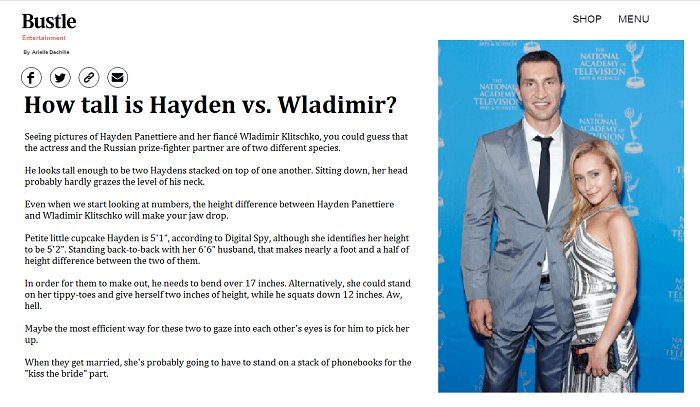
Source: Bustle
Their height difference created a visual juxtaposition that everyone commented on.
We also see a few juxtapositions from some of John F. Kennedy’s most famous speeches.
For example, JFK once said, “We shall never negotiate out of fear and never fear to negotiate.”
Take a look:
This quote had a rhetorical effect that JFK was fond of.
The former president also notably said, “Ask not what your country can do for you — ask what you can do for your country.”
The reversal of the words provides a sharp contrast between the ideas.
Here’s another one:
You’ve heard the saying, “Making a mountain out of a molehill,” right?
This juxtaposition is the size difference. A mountain is huge while a molehill is tiny.
Finally, another example is, “You can’t teach an old dog new tricks.”
The contrast between new and old highlights the difficulty of learning new things after you get stuck in your ways.
Now you might be asking…
Why Use Juxtaposition?
Let’s be honest.
Writers are more intentional than some people give us credit for.
Because here’s the deal:
When you use literary terms like juxtaposition, you’re adding complexity to your writing. You can use it to tug at their heartstrings, create suspense, or provide comedic relief.
Next thing you know?
You’re engaging your reader on a deeper level.
Take Star Wars, for example.
Even if you’ve never watched any of the movies, you’re probably familiar with the iconic line, “No. I am your father.”
Darth Vader plays the villain while Luke Skywalker is the hero. This foil technique creates suspense in the storyline.
More importantly?
It led us to a few captivating plot twists in the end:
- Luke realizes his father isn’t dead
- Luke realizes his father is nothing like what he’s been told
- Luke discovers the man he has despised (Darth Vader) is actually the person he thought he looked up to
And that, my friend, is how you create a storyline people still talk about decades later.
Now It’s Time to Put These Juxtaposition Examples to Use
The secret’s out.
Juxtapositions help your readers draw comparisons between things they might’ve missed otherwise. It’ll also lure them in and make them think.
But don’t just take it from me.
Try it and let the results speak for themselves. Because in the end, all of this is completely useless if you never try it.
So, get inspired to write and use juxtapositions like oxymorons, foils, and antitheses.
You’ll be glad you did.
The post 20 Illuminating Juxtaposition Examples if You’re Feeling Lost appeared first on Smart Blogger.

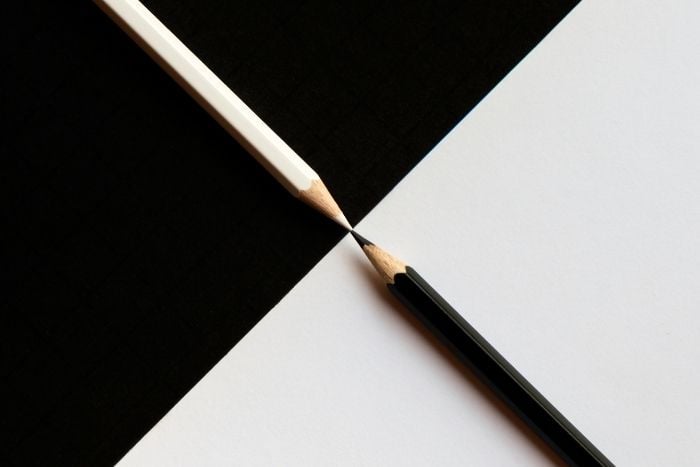
No comments:
Post a Comment